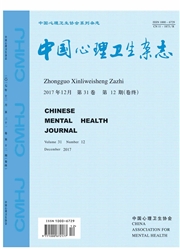

 中文摘要:
中文摘要:
目的:探讨首发精神分裂症患者、高危人群及超高危人群的认知功能特点。方法:收集符合美国精神疾病诊断与统计手册第4版(DSM-IV)的首发精神分裂症患者(41例)、符合精神病风险综合征(SIPS)诊断标准的超高危人群(25例)、精神分裂症患者的非精神病一级亲属(31例)、健康人群(27例),采用连线测验(TMTA)、符号编码、霍普金斯词语学习测验修订版(HVLT)、持续操作测验(CPT)、Stroop色词测验进行认知功能测评。结果:四组人群在连线测验(F=11.45,P〈0.001)、符号编码(F=11.69,P〈0.001)、HVL-T—R(F:5.34,P〈0.05)、Stroop单字(F=2.79,P〈0.05)、Stroop单色(F=3.73,P〈0.05)、Stroop色词(F=3.83,P〈0.05)及CPT测验(F=13.62,P〈0.05)中差异均有统计学意义。患者一级亲属和超高危人群认知功能介于首发精神分裂症患者和健康人群之间,且患者一级亲属要好于超高危人群(Ps〈0.05)。结论:精神分裂症的患者一级亲属、超高危个体以及首发精神分裂症患者的认知功能损害依次加重,提示认知损害的程度与患病风险相关。
 英文摘要:
英文摘要:
Objective: To explore the characteristics of cognitive function in first episode patients (FES), ul- tra-high risk subjects (UHRs) and non-psychotic first-degree relatives of schizophrenia (FDRs), in comparison with healthy controls (HCs). Methods: Forty-one FES patients which met the Diagnostic and Statistical Manual of Men- tal Disorders, the Fourth'Edition (DSM-IV) criteria for schizophrenia, 31 UHRs which met the Structured Interview for Psychosis-risk Syndromes (SIPS), 25 FDRs of patients with schizophrenia (unrelated to the FES group), and 27 HCs were recruited. They were assessed with the connection test (TMTA), symbol coding, hopkins verbal learning test revision (HVLT), continuous performance test (CPT), and Stroop color-word test for evaluation of cognitivefunction. Results: After controlling for basic demographic characteristics including age, gender and educational lev- el, there was a significant difference between FES, FDRs, UHRs and HCs with respect to TMTA ( F = 11.45, P 〈 0.001), symbol encoding ( F = 11.69, P 〈 0.001), HVLT-R( F = 5.34, P 〈 0.05), Stroop word test ( F = 2.79, P 〈 0. 05), Stroop color test F = 3.73, P 〈 0. 05), Stroop color-word test ( F = 3.83, P 〈 0. 05) and the CPT test ( F = 13.62, P 〈0. 05). FES patients performed worse than FDRs, UHRs, or HCs. FDRs performed better than UHRs in the following tests (Ps 〈 0. 05). Conclusion: The severity of cognitive impairments is associated with the risk of de- veloping schizophrenia.
 同期刊论文项目
同期刊论文项目
 同项目期刊论文
同项目期刊论文
 期刊信息
期刊信息
